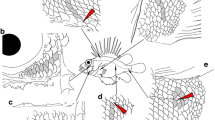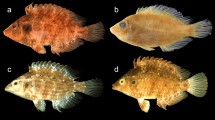Abstract
Antarctic barbeled plunderfishes of the genus Pogonophryne are the most speciose notothenioid group, comprising about 20 poorly known recognized species. The interspecific systematics within the genus is complex, because the various species vary little morphologically. One of these previously unknown forms captured as by-catch of the Antarctic toothfish (Dissostichus mawsoni) fishery during the Antarctic summer 2009–2010 in deep waters of the western Ross Sea is described herein as new species Pogonophryne tronio. The description is based on 2 adult specimens, captured at depths 900–1,015 m: the holotype (male, 290 mm TL, 234 mm SL), paratype (female, 315 mm TL, 260 mm SL). This species, a short-barbeled form of the dorsally spotted “P. mentella” group of species, is compared morphologically to the closely related P. brevibarbata and P. ventrimaculata, using type specimens of both species. P. tronio sp. n. is characterized by the following combination of characters: a short (about 10–12 % SL), slender, tapered and bicolored (dark basally, light distally) mental barbel without a conspicuous terminal expansion; tip of barbel slightly flattened and covered by short tapered finger-like processes basally and flattened, leaf-like processes distally; a slightly protruding lower jaw; a relatively low (about 18 % SL) second dorsal fin lacking the elevated anterior lobe occurring in males of some species in the genus, sharply striped pectoral and caudal fins; the dorsal surface of the head and the area anterior to the first dorsal fin covered with large dark-brown blotches and spots.









Similar content being viewed by others
References
Andriashev AP (1967) Review of the plunder fishes of genus Pogonophryne Regan (Harpagiferidae) with descriptions of five new species from the East Antarctic and South Orkney Islands [In Russian]. In: Andriashev AP, Ushakov PV (eds) Biological Researches of the Soviet Antarctic Expedition (1955–1958), vol 3. pp 389–412
Balushkin AV, Eakin RR (1998) A new toad plunderfish Pogonophryne fusca sp. nova (Fam. Artedidraconidae: Notothenioidei) with notes on species composition and species groups in the genus Pogonophryne Regan. J Ichthyol 38:574–579
Balushkin AV, Petrov AF, Prutko VG (2010) Pogonophryne brevibarbata sp. nov. (Artedidraconidae, Notothenioidei, Perciformes)—a new species of toadlike plunderfish from the Ross Sea, Antarctica [In Russian]. Proc Zool Inst Russian Acad Sci 314:381–386
Cziko PA, Cheng CHC (2006) A new species of nototheniid (Perciformes: Notothenioidei) fish from McMurdo Sound, Antarctica. Copeia 4:752–759
Donnely J, Torres JJ, Sutton TT, Simoniello C (2004) Fishes of the eastern Ross Sea, Antarctica. Polar Biol 27:637–650
Eakin RR (1977) Morphology and distribution of species in the genus Pogonophryne (Pisces, Harpagiferidae). Antarct Res Ser 28:1–20
Eakin RR (1981) Two new species of Pogonophryne (Pisces, Harpagiferidae) from the Ross Sea, Antarctica. Antarct Res Ser 31:155–159
Eakin RR (1987) Two new species of Pogonophryne (Pisces, Harpagiferidae) from the Weddell Sea, Antarctica. Arch FischWiss 38:57–74
Eakin RR (1990) Artedidraconidae. In: Gon O, Heemstra PC (eds) Fishes of the Southern Ocean. JLB Smith Institute of Ichthyology, Grahamstown, pp 332–356
Eakin RR, Kock K-H (1984) Fishes of the genus Pogonophryne (Pisces, Harpagiferidae) collected during cruises of the Federal Republic of Germany (1975–1981) in West Antarctica and in the Weddell Sea. Arch Fisch 35:17–42
Eakin RR, Eastman JT, Matallanas J (2008) New species of Pogonophryne (Pisces, Artedidraconidae) from the Bellingshausen Sea, Antarctica. Polar Biol 31:1175–1179
Eakin RR, Eastman JT, Near TJ (2009) A new species and a molecular phylogenetic analysis of the Antarctic fish genus Pogonophryne (Notothenioidei: Artedidraconidae). Copeia 4:705–713
Eastman JT, Hubold G (1999) The fish fauna of the Ross Sea, Antarctica. Antarct Sci 11:293–304
Gerasimchuk VV, Neyelov AV, Tankevich PB, Shandikov GA (1990) Fishes of the Davis and Mawson Seas and the Pryds Bay (according to materials of the scientific-commercial expeditions by AzcherNIRO in 1978 and 1983) [In Russian]. In: Ecology and morphology of fishes. Proceedings of zoological institute USSR academy of sciences, Leningrad, vol 222, pp 18–41
Iwami T, Abe T (1981) The collection of the fishes trawled in the Ross Sea. Antarct Rec Natl Inst Polar Res 71:130–141
Iwami T, Numanami H, Naito Y (1996) Behavior of three species of the family Artedidraconidae (Pisces, Notothenioidei), with reference to feeding. The collection of the fishes trawled in the Ross Sea. Proc Antarct Rec Natl Inst Polar Res Symp Polar Biol 9:225–230
La Mesa M, Eastman JT, Vacchi M (2004) The role of notothenioid fish in the food web of the Ross Sea shelf waters: a review. Polar Biol 27:321–338
Lombarte A, Olaso I, Bozzano A (2003) Ecomorphological trends in the Artedidraconidae (Pisces: Perciformes: Notothenioidei) of the Weddell Sea. Antarct Sci 15:211–218
Matallanas J, Olaso I (2007) Fishes of the Bellingshausen Sea and Peter I Island. Polar Biol 30:333–341
Near T, Dornburg A, Kuhn KL, Eastman JT, Pennington JN, Patarnello T, Zane L, Fernandez DA, Jones CD (2012) Ancient climate change, antifreeze and the evolutionary diversification of Antarctic fishes. PNAS 109:3434–3439 + Supplement 1–3 pp. www.pnas.org/cgi/doi/10.1073/pnas.1115169109
Neyelov AV, Prirodina VP (2006) Description of Harpagifer permitini sp. nova (Harpagiferidae) from the sublittoral zone of South Georgia and redescription of the littoral H. georgianus Nybelin. J Ichthyol 46:1–12
Prirodina VP (2002) Redescription of littoral and deep-sea species of the genus Harpagifer (Harpagiferidae, Notothenioidei) off islands of the Indian Ocean Sector of the Southern Ocean with the description of a new species. J Ichthyol 42:701–712
Prirodina VP (2004) Harpagifer crozetensis sp. nova (Harpagiferidae, Notothenioidei)—a new species from the littoral of the Crozet Islands (Indian Ocean Sector of Antarctic). J Ichthyol 44:395–399
Shandikov GA (2008) Channichthys mithridatis, a new species of icefishes (Perciformes: Notothenioidei: Channichthyidae) from the Kerguelen Islands (East Antarctica), with comments on the taxonomic status of Channichthys normani. J Karazin Kharkiv Natl Univ Ser Biol 814:123–131
Shandikov GA (2011) Channichthys richardsoni sp. n., a new Antarctic icefish (Perciformes: Notothenioidei: Channichthyidae) from the Kerguelen Islands area, Indian sector of the Southern Ocean. J Karazin Kharkiv Natl Univ Ser Biol 971:125–134
Shandikov GA (2012) Antarctic fish fauna: the origin and modern aspects [In Russian]. In: Current problems of theoretical and practical ichthyology. Proceedings of Vth international ichthyological science practice conference, Chernivtsi, Knygy-XXI, pp 253–258
Shandikov GA, Faleeva TI (1992) Features of gametogenesis and sexual cycles of six notothenioid fishes from East Antarctica. Polar Biol 11:615–621
Takahashi M, Iwami T (1997) The summer diet of demersal fish at the South Shetland Islands. Antarct Sci 9:407–413
Acknowledgments
We would like to thank Juan Agulló Garcia, a Spanish scientific observer (Instituto Español de Oceanografía, Santa Cruz de Tenerife) for his encouragement and very useful assistance in separating of by-catch fishes from the hauls of Antarctic toothfish. We are very thankful to the crew of F/V Tronio, especially to captain Modesto Riveira, for their helping in collecting of fishes and in processing of preliminary technical data during the cruise. Also, we are very grateful to Juan Regal (Grupo Regal, Spain), the owner of the vessel, for his understanding of the relevance of scientific work on board of the commercial fishery vessel and for his personal attentive interest favouring the scientific investigations of Antarctic fishes. Our thanks also due to Marina Kovalenko (lecturer, KhNU) for identifying of parasite, Dmytro Kryvokhyzha (master student, Uppsala University, Sweden) for his technical assistance during preparation of the manuscript and Joseph Eastman (Ohio University, Athens, USA) and Tetsuo Iwami (Tokyo Kasei Gakuin University, Japan) for their useful comments which significantly improved the manuscript.
Author information
Authors and Affiliations
Corresponding author
Rights and permissions
About this article
Cite this article
Shandikov, G.A., Eakin, R.R. & Usachev, S. Pogonophryne tronio, a new species of Antarctic short-barbeled plunderfish (Perciformes: Notothenioidei: Artedidraconidae) from the deep Ross Sea with new data on Pogonophryne brevibarbata . Polar Biol 36, 273–289 (2013). https://doi.org/10.1007/s00300-012-1258-4
Received:
Revised:
Accepted:
Published:
Issue Date:
DOI: https://doi.org/10.1007/s00300-012-1258-4




